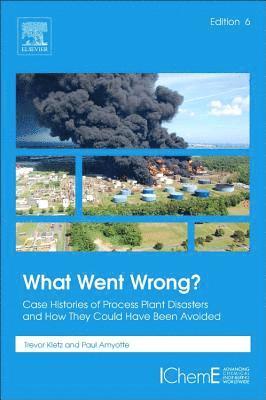
- Format
- EPUB
- Språk
- Engelska
- Antal sidor
- 840
- Utgivningsdatum
- 2019-08-06
- Upplaga
- 6
- Förlag
- Elsevier - Health Sciences Division
- Medarbetare
- Amyotte, Paul
- Dimensioner
- 231 x 155 x 48 mm
- Vikt
- Antal komponenter
- 1
- ISBN
- 9780128105399
- 1430 g
What Went Wrong?
Case Histories of Process Plant Disasters and How They Could Have Been Avoided
- Skickas från oss inom 5-8 vardagar.
- Fri frakt över 249 kr för privatkunder i Sverige.
Passar bra ihop
De som köpt den här boken har ofta också köpt Braiding Sweetgrass av Robin Wall Kimmerer (häftad).
Köp båda 2 för 1151 krKundrecensioner
Fler böcker av författarna
-
Still Going Wrong!
Trevor Kletz, Trevor Kletz
-
Computer Control and Human Error
Trevor Kletz
-
An Engineer''s View of Human Error
Trevor Kletz
Övrig information
Trevor Kletz, OBE, D.Sc., F.Eng. (1922-2013), was a process safety consultant, and published more than a hundred papers and nine books on loss prevention and process safety, including most recently Lessons From Disaster: How Organizations Have No Memory and Accidents Recur and Computer Control and Human Error. He worked thirty-eight years with Imperial Chemical Industries Ltd., where he served as a production manager and safety adviser in the petrochemical division, also holding membership in the Department of Chemical Engineering at Loughborough University, Leicestershire, England. He most recently served as senior visiting research fellow at Loughborough University, and adjunct professor at the Mary Kay O'Connor Process Safety Center, Texas A&M University. Paul Amyotte is a Distinguished Research Professor and Professor of Chemical Engineering at Dalhousie University (Halifax, Canada). He is a chemical engineering graduate of the Royal Military College of Canada (Bachelor's), Queen's University (Master's), the Technical University of Nova Scotia (PhD) and a registered professional engineer in Nova Scotia. Dr. Amyotte is a member and past president of Canadian Society of Chemical Engineering, a member of American Institute of Chemical Engineers, a Fellow of Chemical Institute of Canada, the Engineering Institute of Canada, Canadian Academy of Engineering, Engineers Canada, and the Canadian Academy of Engineering. Dr. Amyotte has an extensive record of authorship, with six books, several book chapters, and over 350 papers published in peer-reviewed journals or presented at national and international conferences. He has presented invited plenary lectures at symposia in Canada, France, Italy, Malaysia, Netherlands, Norway, Poland, Qatar, Taiwan, and the United States. He is the current editor of the Journal of Loss Prevention in the Process Industries, and a past president of the Canadian Society for Chemical Engineering, Engineers Nova Scotia, and Engineers Canada. He has also served as chair of the Canadian Engineering Qualifications Board, member of the Canadian Engineering Accreditation Board, and co-chair of the Materials and Chemical Engineering Evaluation Group of the Natural Sciences and Engineering Research Council of Canada. Dr. Amyotte has consulted on numerous industrial projects involving hazard analysis, incident investigation, and material explosibility. Dr. Amyotte is a recipient of distinct awards including Cybulski Medal from the Polish Academy of Sciences, the Trevor Kletz Merit Award from the Mary Kay O'Connor Process Safety Center, and the Process Safety Management Award from the Canadian Society for Chemical Engineering.
Innehållsförteckning
INTRODUCTION
1. Case Histories and Their Use in Enhancing Process Safety Knowledge
2. Bhopal
3. Opportunities for Reflection
MAINTENANCE AND OPERATIONS
4. Maintenance: Preparation and Performance
5. Operating Methods
6. Entry to Vessels and Other Confined Spaces
7. Accidents Said to Be Due to Human Error
8. Labeling
9. Testing of Trips and Other Protective Systems
10. Opportunities for Reflection
EQUIPMENT AND MATERIALS OF CONSTRUCTION
11. Storage Tanks
12. Stacks
13. Pipes and Vessels
14. Tank Trucks and Tank Cars
15. Other Equipment
16. Materials of Construction
17. Opportunities for Reflection
HAZARDS AND LOSS OF CONTAINMENT
18. Leaks
19. Liquefied Flammable Gases
20. Hazards of Common Materials
21. Static Electricity
22. Reactions - Planned and Unplanned
23. Explosions
24. Opportunities for Reflection
KNOWLEDGE AND COMMUNICATION
26. Poor Communication
27. Accidents in Other Industries
28. Accident Investigation - Missed Opportunities
29. Opportunities for Reflection
DESIGN AND MODIFICATIONS
30. Inherently Safer Design
31. Changing Procedures Instead of Designs
32. Both Design and Operations Could Have Been Better
33. Modifications: Changes to Equipment and Processes
34. Modifications: Changes in Organization
35. Reverse Flow, Other Unforeseen Deviations, and Hazop
36. Control
37. Opportunities for Reflection
CONCLUSION
38. An Accident That May Have Affected the Future of Process Safety
39. An Accident That Did Not Occur
40. Summary of Lessons Learned
APPENDICES
1. Relative Frequencies of Incidents
2. Why Should We Publish Accident Reports?
3. Some Tips for Accident Investigators
4. Recommended Reading
5. Afterthoughts
Du kanske gillar
-
Nexus
Yuval Noah Harari
Häftad -
Orbital
Samantha Harvey
Häftad


